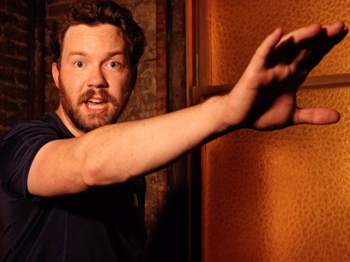
The Reynards and Volpones in Titas Halder's Run the Beast Down are not furry lap-fauna, however, but brush-tailed marauders who have forsaken their rapidly-diminishing woodland sanctuaries in the London suburbs to reclaim territories usurped by human gentrification, their feral encroachment upon newly-constructed dwellings gradually escalating from scavenging in trash cans to invading high-rise kitchens, slaughtering pet cats and molesting babies in cradles.
What makes these nocturnal plunderers even more menacing in Halder's play is that we in the audience never see them. We hear them, though, lurking outside the solitary apartment where Charlie, our reluctant hero, recounts a saga of recession-fueled civil disorder reflected in visions of a spectral "King Fox" and a vertigo-inducing soundscape blending the piteous cries of helpless victims, the mocking laughter of triumphant predators and the clamor of angry crowds.
"I always viewed the foxes as unknowable Lovecraftian sentinels," says sound designer Daniel Etti-Williams. Rather than simply incorporating a generic Cthulhu-monster into the show ("no matter how cool that would be"), however, he and the production team addressed the challenge of separating what they brought to the story from what was actually supported by the text.
For example, Halder's anthropomorphic dimension mandated an extensive vulpine vocabulary, but few audio libraries include zoological glossaries of any magnitude. After rejecting aural collages of diverse animal noises ("foxes, dogs—and I think I threw in some lions, just for good measure"), as well as the feasibility of field recording in forest preserves, it was finally decided to attack the problem from a different angle.
In the course of the show, actor Gage Wallace must mimic the voices of the pastoral deities whose yelps disrupt the sleep of the insomnia-racked Charlie, so the "conversation" of the foxes was modeled on our narrator's vocal approximations. This conceit, concedes Williams, "would have been a harder sell in London, where urban foxes are more common, but in America, hardly anybody knows what a fox really sounds like."
So does that mean that all those scary Wild Kingdom growls and howls are made by a single actor inside a soundproofed closet? "Well, not all of them" Williams admits, citing contributions from other actors, as well as various other animal calls, and human crowd noises during the accounts of rioting in the city. The mix, he recalls, also includes tracks of enhanced or distorted sounds—e.g. Tibetian Singing Bowls—to produce an exotic effect eventually dubbed the "King Tone" by the company.
"My favorite part of sound design," declares Williams, "is the marriage of realism vs. stylization to make the story clearer in both a particular moment and as a whole, [since] realistic sound effects may not be what you need. Now, that may seem like a lot of competing concepts all at once, but it's the balance of those ideas that's important, which is why you have to step back and see how each one contributes to the larger narrative.
"This requires the collaboration of the whole production team. We spent a lot of time asking ourselves about the story we wanted to tell, our goal being to find ourselves a road map before going in and turning knobs, pulling back and leaning in until we got something that we were all happy with."
Run the Beast Down continues online at www.strawdog.org through November 1.
Mary Shen Barnidge
Contributing Writer
